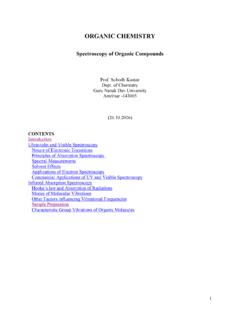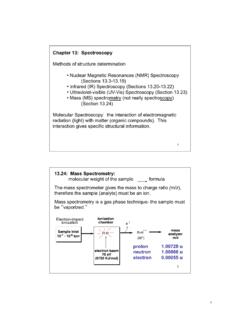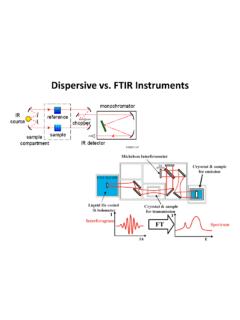Transcription of RAMAN SPECTROSCOPY - G.C.G.-11
1 RAMAN SPECTROSCOPYS cattering Mid-IR and NIRrequire absorption of radiation from a ground level to an excited state, requires matching of radiation from source with difference in energy states. RAMAN spectroscopyinvolves scattering of radiation (matching of radiation is not required). SampleI0(n)I(n)n0n0-RayleighSamplen0 nM-RamanIR Spectrography -AbsorptionRaman Spectrography -ScatteringLaserdetectorLaserdetectorRAM AN SCATTERING RAMAN SPECTROSCOPY is concerned with radiation scattering from a sample. Scattering occurs when an incident photon interacts with the electric dipole of a molecule.
2 This scattering process can be either elastic or Scattering When light encounters molecules, the predominant mode of scattering is elastic scattering, calledRayleigh Scattering. It is also possible for the incident photons to interact with the molecules in such a way that energy is either gained or lost so that the scattered photons are shifted in frequency. Such inelasticscattering is calledRaman scattering. RAMAN SPECTROSCOPYR aman Scattering A small fraction of light is scattered at energies different than that of the incident photons ( RAMAN effect).
3 The RAMAN effect is an inelastic process and was first observed in 1928. Chandrasekhara Venkata RAMAN awarded Nobel prize in Scattering & RAMAN Effect (IV)Electronic Adsorption LevelVirtual levelVirtual levelnIRnonono-nno+ nERayleighScatteringStokesRaman ScatteringAnti-StokesRaman ScatteringnoInitialFinalFinalInitialInit ialFinalRaman SPECTROSCOPY A single frequency of radiation irradiates the molecule and the radiation distorts (polarizes) the cloud of electrons surrounding the nuclei to form a short-lived state called a virtual state.
4 This state is not stable, persist for the short timescale of the scattering processand the photon is quickly re-radiated. Stokes ScatteringStokes scatteringresult when molecules are in their ground state where it interacts with the beam of light and some of energy from the colliding photon is channeled into the vibrational mode of the causes the light to be absorbed and then re-emitted at lower ScatteringAnti stokes scatteringoccurs when molecules are in a vibrationally excited state when it interact with the radiations.
5 The interaction can cause molecules to drop to ground state and lose some of it is vibrational energy to the light and is re-emmited at higher Spectrum RAMAN shift : a wavelength shift or a vibration energy difference Mechanism of RAMAN and Rayleigh rule for RAMAN spectrumVibration is active if it has a change in polarizability, .Polarizability is the ease of distortion of a bond. For RAMAN -active vibrations, the incident radiation does not cause a change in the dipole moment of the molecule, but instead a change in starting the vibration going, the electric field of the radiation at time t, E, induces a separation of charge ( between the nuclear protons and the bonding electrons).
6 This is called the induced dipole moment, P. (Don t confuse it with the molecule s dipole moment, or change in dipole moment, because this is often zero).P = E However, the polarizability a of many molecules depends on the orientation of the molecule relative to the applied field ( the rotation), or to the separation of the atoms in the molecule ( the vibration). The polarizability is then anisotropic, depends on direction. The polarizability of a molecule in various directions is conventionally represented by its polarizability Exclusion PrincipleFor molecules with a center of symmetry, no IR active transitions are RAMAN active and vice versa Symmetric moleculesIR-active vibrations are not vibrations are not = C = OO = C = ORaman active RAMAN inactiveIR inactiveIR activeRaman-active and Non- RAMAN -active Vibrations (thevibrationisRamanactive).
7 & Asymmetric Stretching of CO2 Symmetric Stretching of CO2 ((( RAMAN -active )n1=1340 cm-1No change in dipole moment IR inactiveChange in polarizability RAMAN activeAsymmetric Stretching of CO2 (Non- RAMAN -active Vibrations)O=C=OChange so much in dipole moment IR activeNon-change in polarizability RAMAN inactiven2= 2350 cm-1O=C=ORotational RAMAN Spectrum Selection rules for RAMAN SPECTROSCOPY Rotational RAMAN The first requirement is that the polarizability of the molecule must be anisotropic it must depend on the orientation of the molecule.))
8 As a result, RAMAN SPECTROSCOPY is less restrictive than pure rotational SPECTROSCOPY , as linear symmetric molecules which do not possess permanent dipole moments, such as CO2, O2, N2, do have rotational RAMAN spectra. On the other hand, spherical top molecules such as CH4 and SF6 still do not have rotational RAMAN spectra as they do not have an anisotropic RAMAN EffectSelection RuleJ321010B6B2B0EJ6B10B14B6B10B14BJ3210 10B6B2B0 EJAnti-StokesSOQ The laser beam (from, for example, an Nd : YAG laser with l = 532 nm, or a rare gas laser) is passed through a cell, usually a narrow glass or quartz tube filled with the sample.
9 Radiation scattered sideways from the sample is collected by a lens and passed into a grating monochromator similar to that used in a dispersive infrared instrument. The signal is measured by a sensitive photomultiplier and, after amplification, is processed by a computer which plots the RAMAN of RAMAN Effects (1). RAMAN SPECTROSCOPY can be used not only for gases but also for liquids & solids for which the infrared spectra are so diffuse as to be of little quantitative value. (2). RAMAN Effect is exhibited not only bypolar moleculesbut also by non-polar molecules such as O2, N2, Cl2 etc.
10 (3). The rotation-vibration changes in non-polar molecules can be observed only by RAMAN SPECTROSCOPY . (4). The most important advantage of RAMAN Spectra is that it involves measurement of frequencies of scattered radiations, which are only slightly different from the frequencies of incident radiations. Thus, by appropriate choice of the incident radiations, the scattered spectral lines are brought into a convenient region of the spectrum, generally in thevisible regionwhere they are easily observed. The measurement of the corresponding infrared spectra is much more difficult.














